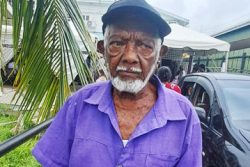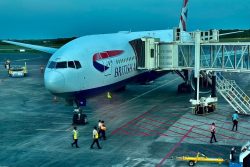If the business sector can take advantage of the economic opportunities that Cricket World Cup 2007 (CWC 2007) is likely to bring to Guyana the longer term benefits could be worth billions of dollars. Chief Executive Officer of the CWC Local Organizing Committee (LOC) Mr. Karran Singh believes that “It is the individual businesses on the ground that will make the money, the hotel industry, the night clubs, restaurants, tourist resorts, the taxi drivers, the minibuses, and the supporting sectors such as agriculture. These are the people who will benefit.”
CWC 2007 Chief Executive Officer Chris Dehring is also upbeat about the potential financial rewards that CWC 2007 can bring to the region. “Events of this type generate tremendous activity in the economies of the hosting nations. It can jump-start economies that might have been lagging behind somewhat. There is more focus on capital expenditure and the Cricket World Cup acts as a catalyst in getting them achieved. There is road building, the upgrading of hospitals, airports, and general levels of service. It really puts an onus on the countries to improve their infrastructure, and this all helps to facilitate tourism growth as well, of course.”
Dehring told Caribbean Beat, an online news magazine, that a successful World Cup will also highlight the Caribbean’s capabilities. “Hosting a mega-event exposes the capabilities of the region to the world. The knowledge transfer and development of managerial capabilities inherent in hosting a tournament like this are huge. It gives the region and the countries individually the confidence that they will be considered for future events.”
While uncertainty persists with regard to the likely number of visitors to Guyana for Cricket World Cup the past year has witnessed heavy investment in the renovation of existing hotels and guest houses and the construction of new ones. Some estimates suggest that Guyana could be required to provide accommodation for up to 15,000 visitors for the six matches in the Super Eight section of the tournament. To help satisfy this requirement the LOC has initiated a “bed and breakfast” initiative and the most recent information suggests that as many as 1,500 rooms may be available in Guyanese homes. Bed and Breakfast rates reportedly range from US$65 to US$110 per night. While bookings for Bed and Breakfast accommodation have been slow up to this time the LOC is confident that as the situation with regard to the fixtures for the Guyana matches becomes clearer bookings will “pick up.”
The transformation in the hotel sector resulting from the onset of CWC has been dramatic. Proprietors of older establishments have taken advantage of duty-free concessions offered by government to import material and equipment necessary for extensive renovation and repairs while more than a dozen new small hotels have ‘sprung up’ across the capital. The advent of these new facilities, however, raise discomfiting questions regarding the local capacity to provide the quality of service that the visitors are likely to expect.
Up to this time so far, the International Cricket Council has given its seal of approval to the Le Meridien, Cara Lodge, Cara Suites, Roraima Inn, Blue Wave, Ariantze, and Buddy’s International Hotel.
Informed estimates suggest that CWC visitors could spend up to US$200.00 on meals and accommodation alone. Even this modest estimate means that more than US$40m could be left behind.
If the hotel and services sector are upbeat about the forthcoming CWC the rest of the business community is somewhat more cautious. The local handicraft sector, for example, is constrained by the sunset legislation which has designated “approved” CWC souvenirs to be sold at specific outlets including the Providence Stadium. While many of the producers and vendors say they will take their chances simply selling their craft on the street they remain uncertain as to the degree of success that they will realize among visitors who may well be focusing on securing only official souvenirs.
The Calabash Gift Shoppe, the official licensee for CWC souvenirs has begun marketing an assortment of CWC 2007 souvenirs and while co-owner Elizabeth Deane-Hughes has said that she is encouraged by the public response she is also concerned about the recent appearance on the local market of imported fake CWC souvenirs. That notwithstanding, Deane-Hughes believes that CWC could provide an opportunity to kickstart an industry that has, up until now, not moved beyond a subsistence level.
Some tour operators have reported increased demand for tours both in and out of Georgetown. Sabita Singh of Rainforest Tours told the Guyana Review after a slow start “there has been a rapid increase in bookings during the past weeks.” She said the Kaieteur Falls is the preferred destination for most of the clients. Shanklands Resort owned by the Jardim Family revealed that they have had to close bookings for the CWC 2007 period since several of their regular customers had made advance bookings for that particular period. Baganara Resort, Evergreen Adventures and Wonderland Tours reported slow progress but are optimistic things will “pick up by early March.”
While it is difficult to estimate the likely demand for food during the CWC “season” fish, meat, fruit, eggs and vegetables will all be in high demand. Whatever the “greater attractions” afforded by the tourism-oriented islands Guyana certainly holds its own in terms of foods and local farmers ought to be able to “cash in” at least for the period of the event. What CWC unquestionably offers Guyana is an opportunity to showcase its cuisine to visitors and to establish a reputation as the culinary haven of the region.
From all reports CWC-related spending has long been apparent. Additional services have meant that the service sector has had to recruit more staff and money has also been changing hands through the purchase of food, materials for repairs, maintenance and new constructions. There is, it seems, something in CWC 2007 for everyone.





